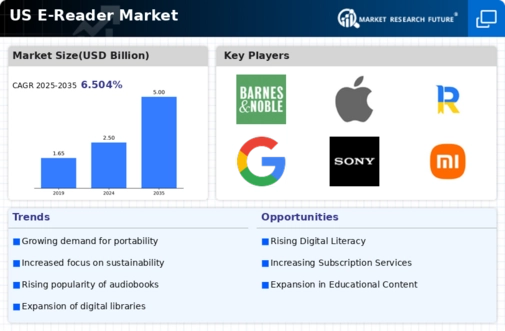The e reader market exhibits a dynamic competitive landscape characterized by rapid technological advancements and shifting consumer preferences. Key players such as Amazon (US), Kobo (CA), and Barnes & Noble (US) are at the forefront, each employing distinct strategies to capture market share. Amazon (US) continues to leverage its extensive ecosystem, integrating e readers with its Kindle Unlimited subscription service, thereby enhancing user engagement and retention. Kobo (CA), on the other hand, focuses on expanding its global footprint through partnerships with local retailers, which allows it to cater to diverse consumer needs. Barnes & Noble (US) appears to be revitalizing its brand by emphasizing a hybrid model that combines physical retail experiences with digital offerings, thus appealing to a broader audience.
The business tactics employed by these companies reflect a moderately fragmented market structure, where localized manufacturing and supply chain optimization play crucial roles. Companies are increasingly localizing their production to mitigate risks associated with global supply chain disruptions. This strategy not only enhances operational efficiency but also allows for quicker response times to market demands. The collective influence of these key players shapes a competitive environment that is both challenging and opportunistic, as they navigate the complexities of consumer expectations and technological advancements.
In September 2025, Amazon (US) announced the launch of its latest Kindle model, which features advanced AI capabilities for personalized reading experiences. This strategic move underscores Amazon's commitment to innovation and its aim to differentiate itself in a crowded market. By integrating AI, the new Kindle model is expected to enhance user engagement through tailored recommendations, potentially increasing customer loyalty and driving sales.
In October 2025, Kobo (CA) unveiled a new partnership with a major European bookstore chain, aiming to expand its digital content offerings. This collaboration is strategically significant as it not only broadens Kobo's market reach but also enhances its content library, making it more competitive against Amazon (US). The partnership reflects a growing trend of digital content integration within traditional retail environments, which may attract a wider audience to e reading.
In August 2025, Barnes & Noble (US) launched a subscription service that combines access to e books and exclusive discounts on physical books. This initiative is indicative of the company's strategy to create a seamless shopping experience that bridges digital and physical formats. By offering such a service, Barnes & Noble (US) aims to strengthen customer loyalty and drive sales across both platforms, positioning itself as a versatile player in the e reader market.
As of November 2025, current trends in the e reader market are increasingly defined by digitalization, sustainability, and the integration of AI technologies. Strategic alliances are becoming more prevalent, as companies recognize the value of collaboration in enhancing their competitive edge. Looking ahead, it is likely that competitive differentiation will evolve from traditional price-based strategies to a focus on innovation, technological advancements, and supply chain reliability. This shift may redefine how companies engage with consumers, emphasizing the importance of delivering unique value propositions in an ever-evolving market.

























Leave a Comment